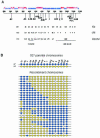The sequence and analysis of Trypanosoma brucei chromosome II
- PMID: 12907728
- PMCID: PMC169936
- DOI: 10.1093/nar/gkg673
The sequence and analysis of Trypanosoma brucei chromosome II
Abstract
We report here the sequence of chromosome II from Trypanosoma brucei, the causative agent of African sleeping sickness. The 1.2-Mb pairs encode about 470 predicted genes organised in 17 directional clusters on either strand, the largest cluster of which has 92 genes lined up over a 284-kb region. An analysis of the GC skew reveals strand compositional asymmetries that coincide with the distribution of protein-coding genes, suggesting these asymmetries may be the result of transcription-coupled repair on coding versus non-coding strand. A 5-cM genetic map of the chromosome reveals recombinational 'hot' and 'cold' regions, the latter of which is predicted to include the putative centromere. One end of the chromosome consists of a 250-kb region almost exclusively composed of RHS (pseudo)genes that belong to a newly characterised multigene family containing a hot spot of insertion for retroelements. Interspersed with the RHS genes are a few copies of truncated RNA polymerase pseudogenes as well as expression site associated (pseudo)genes (ESAGs) 3 and 4, and 76 bp repeats. These features are reminiscent of a vestigial variant surface glycoprotein (VSG) gene expression site. The other end of the chromosome contains a 30-kb array of VSG genes, the majority of which are pseudogenes, suggesting that this region may be a site for modular de novo construction of VSG gene diversity during transposition/gene conversion events.
Figures


Similar articles
-
The DNA sequence of chromosome I of an African trypanosome: gene content, chromosome organisation, recombination and polymorphism.Nucleic Acids Res. 2003 Aug 15;31(16):4864-73. doi: 10.1093/nar/gkg674. Nucleic Acids Res. 2003. PMID: 12907729 Free PMC article.
-
A new, expressed multigene family containing a hot spot for insertion of retroelements is associated with polymorphic subtelomeric regions of Trypanosoma brucei.Eukaryot Cell. 2002 Feb;1(1):137-51. doi: 10.1128/EC.1.1.137-151.2002. Eukaryot Cell. 2002. PMID: 12455980 Free PMC article.
-
Analysis of a donor gene region for a variant surface glycoprotein and its expression site in African trypanosomes.Nucleic Acids Res. 2001 May 15;29(10):2012-9. doi: 10.1093/nar/29.10.2012. Nucleic Acids Res. 2001. PMID: 11353069 Free PMC article.
-
The VSG expression sites of Trypanosoma brucei: multipurpose tools for the adaptation of the parasite to mammalian hosts.Mol Biochem Parasitol. 2001 Apr 25;114(1):1-16. doi: 10.1016/s0166-6851(01)00242-0. Mol Biochem Parasitol. 2001. PMID: 11356509 Review.
-
Switching trypanosome coats: what's in the wardrobe?Trends Genet. 2006 Nov;22(11):614-20. doi: 10.1016/j.tig.2006.08.003. Epub 2006 Aug 14. Trends Genet. 2006. PMID: 16908087 Review.
Cited by
-
Transposons to toxins: the provenance, architecture and diversification of a widespread class of eukaryotic effectors.Nucleic Acids Res. 2016 May 5;44(8):3513-33. doi: 10.1093/nar/gkw221. Epub 2016 Apr 8. Nucleic Acids Res. 2016. PMID: 27060143 Free PMC article.
-
Developmentally regulated instability of the GPI-PLC mRNA is dependent on a short-lived protein factor.Nucleic Acids Res. 2005 Mar 8;33(5):1503-12. doi: 10.1093/nar/gki298. Print 2005. Nucleic Acids Res. 2005. PMID: 15755751 Free PMC article.
-
The DNA sequence of chromosome I of an African trypanosome: gene content, chromosome organisation, recombination and polymorphism.Nucleic Acids Res. 2003 Aug 15;31(16):4864-73. doi: 10.1093/nar/gkg674. Nucleic Acids Res. 2003. PMID: 12907729 Free PMC article.
-
A novel strategy to identify the location of necessary and sufficient cis-acting regulatory mRNA elements in trypanosomes.RNA. 2005 Jul;11(7):1108-16. doi: 10.1261/rna.2510505. Epub 2005 May 31. RNA. 2005. PMID: 15928343 Free PMC article.
-
Heat shock causes a decrease in polysomes and the appearance of stress granules in trypanosomes independently of eIF2(alpha) phosphorylation at Thr169.J Cell Sci. 2008 Sep 15;121(Pt 18):3002-14. doi: 10.1242/jcs.031823. Epub 2008 Aug 19. J Cell Sci. 2008. PMID: 18713834 Free PMC article.
References
-
- Barrett M.P. (1999) The fall and rise of sleeping sickness. Lancet, 353, 1113–1114. - PubMed
-
- Johnson P.J., Kooter,J.M. and Borst,P. (1987) Inactivation of transcription by UV irradiation of T.brucei provides evidence for a multicistronic transcription unit including a VSG gene. Cell, 51, 273–281. - PubMed
-
- Boothroyd J.C. and Cross,G.A. (1982) Transcripts coding for variant surface glycoproteins of Trypanosoma brucei have a short, identical exon at their 5′ end. Gene, 20, 281–289. - PubMed
-
- Walder J.A., Eder,P.S., Engman,D.M., Brentano,S.T., Walder,R.Y., Knutzon,D.S., Dorfman,D.M. and Donelson,J.E. (1986) The 35-nucleotide spliced leader sequence is common to all trypanosome messenger RNA’s. Science, 233, 569–571. - PubMed
-
- Stuart K. and Panigrahi,A.K. (2002) RNA editing: complexity and complications. Mol. Microbiol., 45, 591–596. - PubMed
Publication types
MeSH terms
Substances
Associated data
- Actions
- Actions
- Actions
- Actions
- Actions
- Actions
- Actions
- Actions
- Actions
- Actions
- Actions
Grants and funding
LinkOut - more resources
Full Text Sources
Other Literature Sources
Miscellaneous

